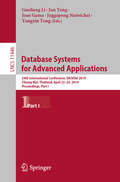 Database Systems for Advanced Applications: 24th International Conference, DASFAA 2019, Chiang Mai, Thailand, April 22–25, 2019, Proceedings, Part I (Lecture Notes in Computer Science #11446)
5929059
Database Systems for Advanced Applications: 24th International Conference, DASFAA 2019, Chiang Mai, Thailand, April 22–25, 2019, Proceedings, Part I (Lecture Notes in Computer Science #11446)
5929059
|
Jun Yang
Yongxin Tong
Guoliang Li
Joao Gama
Juggapong Natwichai
|
9783030185763 |
2019 |
Contains images
|
|
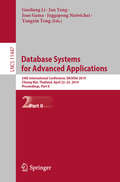 Database Systems for Advanced Applications: 24th International Conference, DASFAA 2019, Chiang Mai, Thailand, April 22–25, 2019, Proceedings, Part II (Lecture Notes in Computer Science #11447)
5926651
Database Systems for Advanced Applications: 24th International Conference, DASFAA 2019, Chiang Mai, Thailand, April 22–25, 2019, Proceedings, Part II (Lecture Notes in Computer Science #11447)
5926651
|
Jun Yang
Yongxin Tong
Guoliang Li
Joao Gama
Juggapong Natwichai
|
9783030185794 |
2019 |
Contains images
|
|
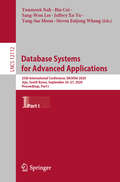 Database Systems for Advanced Applications: 25th International Conference, DASFAA 2020, Jeju, South Korea, September 24–27, 2020, Proceedings, Part I (Lecture Notes in Computer Science #12112)
5925754
Database Systems for Advanced Applications: 25th International Conference, DASFAA 2020, Jeju, South Korea, September 24–27, 2020, Proceedings, Part I (Lecture Notes in Computer Science #12112)
5925754
|
Bin Cui
Yang-Sae Moon
Jeffrey Xu Yu
Yunmook Nah
Sang-Won Lee
Steven Euijong Whang
|
9783030594107 |
2020 |
Contains images
|
|
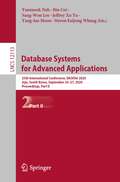 Database Systems for Advanced Applications: 25th International Conference, DASFAA 2020, Jeju, South Korea, September 24–27, 2020, Proceedings, Part II (Lecture Notes in Computer Science #12113)
5920676
Database Systems for Advanced Applications: 25th International Conference, DASFAA 2020, Jeju, South Korea, September 24–27, 2020, Proceedings, Part II (Lecture Notes in Computer Science #12113)
5920676
|
Bin Cui
Yang-Sae Moon
Jeffrey Xu Yu
Yunmook Nah
Sang-Won Lee
Steven Euijong Whang
|
9783030594169 |
2020 |
Contains images
|
|
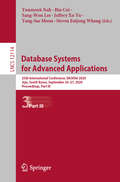 Database Systems for Advanced Applications: 25th International Conference, DASFAA 2020, Jeju, South Korea, September 24–27, 2020, Proceedings, Part III (Lecture Notes in Computer Science #12114)
5925403
Database Systems for Advanced Applications: 25th International Conference, DASFAA 2020, Jeju, South Korea, September 24–27, 2020, Proceedings, Part III (Lecture Notes in Computer Science #12114)
5925403
|
Bin Cui
Yang-Sae Moon
Jeffrey Xu Yu
Yunmook Nah
Sang-Won Lee
Steven Euijong Whang
|
9783030594190 |
2020 |
Contains images
|
|
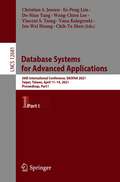 Database Systems for Advanced Applications: 26th International Conference, DASFAA 2021, Taipei, Taiwan, April 11–14, 2021, Proceedings, Part I (Lecture Notes in Computer Science #12681)
3989489
Database Systems for Advanced Applications: 26th International Conference, DASFAA 2021, Taipei, Taiwan, April 11–14, 2021, Proceedings, Part I (Lecture Notes in Computer Science #12681)
3989489
|
Ee-Peng Lim
Vincent S. Tseng
Christian S. Jensen
De-Nian Yang
Jen-Wei Huang
Chih-Ya Shen
Wang-Chien Lee
Vana Kalogeraki
|
9783030731946 |
2021 |
Contains images
|
|
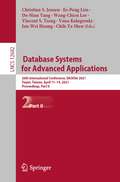 Database Systems for Advanced Applications: 26th International Conference, DASFAA 2021, Taipei, Taiwan, April 11–14, 2021, Proceedings, Part II (Lecture Notes in Computer Science #12682)
4199193
Database Systems for Advanced Applications: 26th International Conference, DASFAA 2021, Taipei, Taiwan, April 11–14, 2021, Proceedings, Part II (Lecture Notes in Computer Science #12682)
4199193
|
Ee-Peng Lim
Vincent S. Tseng
Christian S. Jensen
De-Nian Yang
Jen-Wei Huang
Chih-Ya Shen
Wang-Chien Lee
Vana Kalogeraki
|
9783030731977 |
2021 |
Contains images
|
|
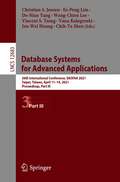 Database Systems for Advanced Applications: 26th International Conference, DASFAA 2021, Taipei, Taiwan, April 11–14, 2021, Proceedings, Part III (Lecture Notes in Computer Science #12683)
3989496
Database Systems for Advanced Applications: 26th International Conference, DASFAA 2021, Taipei, Taiwan, April 11–14, 2021, Proceedings, Part III (Lecture Notes in Computer Science #12683)
3989496
|
Ee-Peng Lim
Vincent S. Tseng
Christian S. Jensen
De-Nian Yang
Jen-Wei Huang
Chih-Ya Shen
Wang-Chien Lee
Vana Kalogeraki
|
9783030732004 |
2021 |
Contains images
|
|
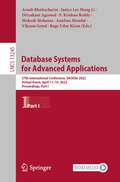 Database Systems for Advanced Applications: 27th International Conference, DASFAA 2022, Virtual Event, April 11–14, 2022, Proceedings, Part I (Lecture Notes in Computer Science #13245)
4571227
Database Systems for Advanced Applications: 27th International Conference, DASFAA 2022, Virtual Event, April 11–14, 2022, Proceedings, Part I (Lecture Notes in Computer Science #13245)
4571227
|
Mukesh Mohania
P. Krishna Reddy
Anirban Mondal
Arnab Bhattacharya
Vikram Goyal
Janice Lee Mong Li
Divyakant Agrawal
Rage Uday Kiran
|
9783031001239 |
2022 |
Contains images
|
|
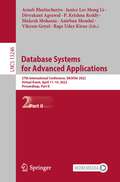 Database Systems for Advanced Applications: 27th International Conference, DASFAA 2022, Virtual Event, April 11–14, 2022, Proceedings, Part II (Lecture Notes in Computer Science #13246)
4571204
Database Systems for Advanced Applications: 27th International Conference, DASFAA 2022, Virtual Event, April 11–14, 2022, Proceedings, Part II (Lecture Notes in Computer Science #13246)
4571204
|
Mukesh Mohania
P. Krishna Reddy
Anirban Mondal
Arnab Bhattacharya
Vikram Goyal
Janice Lee Mong Li
Divyakant Agrawal
Rage Uday Kiran
|
9783031001260 |
2022 |
Contains images
|
|
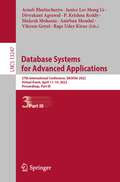 Database Systems for Advanced Applications: 27th International Conference, DASFAA 2022, Virtual Event, April 11–14, 2022, Proceedings, Part III (Lecture Notes in Computer Science #13247)
4666322
Database Systems for Advanced Applications: 27th International Conference, DASFAA 2022, Virtual Event, April 11–14, 2022, Proceedings, Part III (Lecture Notes in Computer Science #13247)
4666322
|
Mukesh Mohania
P. Krishna Reddy
Anirban Mondal
Arnab Bhattacharya
Vikram Goyal
Janice Lee Mong Li
Divyakant Agrawal
Rage Uday Kiran
|
9783031001291 |
2022 |
Contains images
|
|
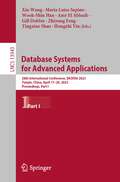 Database Systems for Advanced Applications: 28th International Conference, DASFAA 2023, Tianjin, China, April 17–20, 2023, Proceedings, Part I (Lecture Notes in Computer Science #13943)
5925296
Database Systems for Advanced Applications: 28th International Conference, DASFAA 2023, Tianjin, China, April 17–20, 2023, Proceedings, Part I (Lecture Notes in Computer Science #13943)
5925296
|
Xin Wang
Hongzhi Yin
Zhiyong Feng
Wook-Shin Han
Gill Dobbie
Amr El Abbadi
Maria Luisa Sapino
Yingxiao Shao
|
9783031306372 |
2023 |
Contains images
|
|
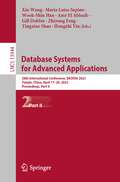 Database Systems for Advanced Applications: 28th International Conference, DASFAA 2023, Tianjin, China, April 17–20, 2023, Proceedings, Part II (Lecture Notes in Computer Science #13944)
5924895
Database Systems for Advanced Applications: 28th International Conference, DASFAA 2023, Tianjin, China, April 17–20, 2023, Proceedings, Part II (Lecture Notes in Computer Science #13944)
5924895
|
Xin Wang
Hongzhi Yin
Zhiyong Feng
Wook-Shin Han
Gill Dobbie
Amr El Abbadi
Maria Luisa Sapino
Yingxiao Shao
|
9783031306723 |
2023 |
Contains images
|
|
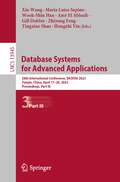 Database Systems for Advanced Applications: 28th International Conference, DASFAA 2023, Tianjin, China, April 17–20, 2023, Proceedings, Part III (Lecture Notes in Computer Science #13945)
5925553
Database Systems for Advanced Applications: 28th International Conference, DASFAA 2023, Tianjin, China, April 17–20, 2023, Proceedings, Part III (Lecture Notes in Computer Science #13945)
5925553
|
Xin Wang
Hongzhi Yin
Zhiyong Feng
Wook-Shin Han
Gill Dobbie
Amr El Abbadi
Maria Luisa Sapino
Yingxiao Shao
|
9783031306754 |
2023 |
Contains images
|
|
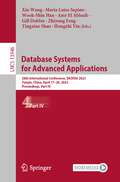 Database Systems for Advanced Applications: 28th International Conference, DASFAA 2023, Tianjin, China, April 17–20, 2023, Proceedings, Part IV (Lecture Notes in Computer Science #13946)
5919865
Database Systems for Advanced Applications: 28th International Conference, DASFAA 2023, Tianjin, China, April 17–20, 2023, Proceedings, Part IV (Lecture Notes in Computer Science #13946)
5919865
|
Xin Wang
Hongzhi Yin
Zhiyong Feng
Wook-Shin Han
Gill Dobbie
Amr El Abbadi
Maria Luisa Sapino
Yingxiao Shao
|
9783031306785 |
2023 |
Contains images
|
|
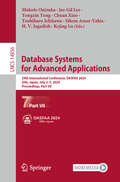 Database Systems for Advanced Applications: 29th International Conference, DASFAA 2024, Gifu, Japan, July 2-5, 2024, Proceedings, Part VII (Lecture Notes in Computer Science #14856)
6158235
Database Systems for Advanced Applications: 29th International Conference, DASFAA 2024, Gifu, Japan, July 2-5, 2024, Proceedings, Part VII (Lecture Notes in Computer Science #14856)
6158235
|
Yoshiharu Ishikawa
Yongxin Tong
Jae-Gil Lee
Chuan Xiao
Sihem Amer-Yahia
Makoto Onizuka
H. V. Jagadish
Kejing Lu
|
9789819755752 |
2024 |
Contains images
|
|
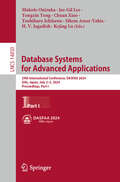 Database Systems for Advanced Applications: 29th International Conference, DASFAA 2024, Gifu, Japan, July 2–5, 2024, Proceedings, Part I (Lecture Notes in Computer Science #14850)
6193121
Database Systems for Advanced Applications: 29th International Conference, DASFAA 2024, Gifu, Japan, July 2–5, 2024, Proceedings, Part I (Lecture Notes in Computer Science #14850)
6193121
|
Yoshiharu Ishikawa
Yongxin Tong
Jae-Gil Lee
Chuan Xiao
Sihem Amer-Yahia
Makoto Onizuka
H. V. Jagadish
Kejing Lu
|
9789819755523 |
2024 |
Contains images
|
|
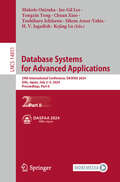 Database Systems for Advanced Applications: 29th International Conference, DASFAA 2024, Gifu, Japan, July 2–5, 2024, Proceedings, Part II (Lecture Notes in Computer Science #14851)
6368889
Database Systems for Advanced Applications: 29th International Conference, DASFAA 2024, Gifu, Japan, July 2–5, 2024, Proceedings, Part II (Lecture Notes in Computer Science #14851)
6368889
|
Yoshiharu Ishikawa
Yongxin Tong
Jae-Gil Lee
Chuan Xiao
Sihem Amer-Yahia
Makoto Onizuka
H. V. Jagadish
Kejing Lu
|
9789819757794 |
2025 |
Contains images
|
|
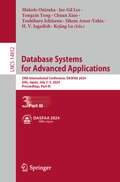 Database Systems for Advanced Applications: 29th International Conference, DASFAA 2024, Gifu, Japan, July 2–5, 2024, Proceedings, Part III (Lecture Notes in Computer Science #14852)
6370691
Database Systems for Advanced Applications: 29th International Conference, DASFAA 2024, Gifu, Japan, July 2–5, 2024, Proceedings, Part III (Lecture Notes in Computer Science #14852)
6370691
|
Yoshiharu Ishikawa
Yongxin Tong
Jae-Gil Lee
Chuan Xiao
Sihem Amer-Yahia
Makoto Onizuka
H. V. Jagadish
Kejing Lu
|
9789819755554 |
2025 |
Contains images
|
|
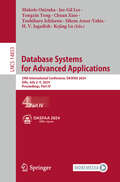 Database Systems for Advanced Applications: 29th International Conference, DASFAA 2024, Gifu, Japan, July 2–5, 2024, Proceedings, Part IV (Lecture Notes in Computer Science #14853)
6571738
Database Systems for Advanced Applications: 29th International Conference, DASFAA 2024, Gifu, Japan, July 2–5, 2024, Proceedings, Part IV (Lecture Notes in Computer Science #14853)
6571738
|
Yoshiharu Ishikawa
Yongxin Tong
Jae-Gil Lee
Chuan Xiao
Sihem Amer-Yahia
Makoto Onizuka
H. V. Jagadish
Kejing Lu
|
9789819755622 |
2024 |
Contains images
|
|
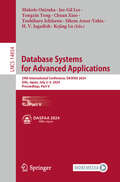 Database Systems for Advanced Applications: 29th International Conference, DASFAA 2024, Gifu, Japan, July 2–5, 2024, Proceedings, Part V (Lecture Notes in Computer Science #14854)
6371380
Database Systems for Advanced Applications: 29th International Conference, DASFAA 2024, Gifu, Japan, July 2–5, 2024, Proceedings, Part V (Lecture Notes in Computer Science #14854)
6371380
|
Yoshiharu Ishikawa
Yongxin Tong
Jae-Gil Lee
Chuan Xiao
Sihem Amer-Yahia
Makoto Onizuka
H. V. Jagadish
Kejing Lu
|
9789819755691 |
2024 |
Contains images
|
|
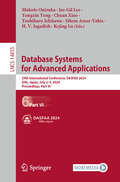 Database Systems for Advanced Applications: 29th International Conference, DASFAA 2024, Gifu, Japan, July 2–5, 2024, Proceedings, Part VI (Lecture Notes in Computer Science #14855)
6197806
Database Systems for Advanced Applications: 29th International Conference, DASFAA 2024, Gifu, Japan, July 2–5, 2024, Proceedings, Part VI (Lecture Notes in Computer Science #14855)
6197806
|
Yoshiharu Ishikawa
Yongxin Tong
Jae-Gil Lee
Chuan Xiao
Sihem Amer-Yahia
Makoto Onizuka
H. V. Jagadish
Kejing Lu
|
9789819755721 |
2024 |
Contains images
|
|
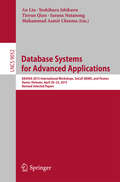 Database Systems for Advanced Applications: DASFAA 2015 International Workshops, SeCoP, BDMS, and Posters, Hanoi, Vietnam, April 20-23, 2015, Revised Selected Papers (Lecture Notes in Computer Science #9052)
2107765
Database Systems for Advanced Applications: DASFAA 2015 International Workshops, SeCoP, BDMS, and Posters, Hanoi, Vietnam, April 20-23, 2015, Revised Selected Papers (Lecture Notes in Computer Science #9052)
2107765
|
An Liu
Yoshiharu Ishikawa
Tieyun Qian
Sarana Nutanong
Muhammad Aamir Cheema
|
9783319223247 |
2015 |
Contains images
|
|
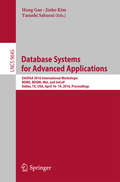 Database Systems for Advanced Applications: DASFAA 2016 International Workshops: BDMS, BDQM, MoI, and SeCoP, Dallas, TX, USA, April 16-19, 2016, Proceedings (Lecture Notes in Computer Science #9645)
2110359
Database Systems for Advanced Applications: DASFAA 2016 International Workshops: BDMS, BDQM, MoI, and SeCoP, Dallas, TX, USA, April 16-19, 2016, Proceedings (Lecture Notes in Computer Science #9645)
2110359
|
Jinho Kim
Hong Gao
Yasushi Sakurai
|
9783319320557 |
2016 |
Contains images
|
|
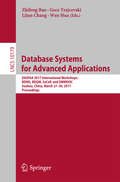 Database Systems for Advanced Applications: DASFAA 2017 International Workshops: BDMS, BDQM, SeCoP, and DMMOOC, Suzhou, China, March 27-30, 2017, Proceedings (Lecture Notes in Computer Science #10179)
2112034
Database Systems for Advanced Applications: DASFAA 2017 International Workshops: BDMS, BDQM, SeCoP, and DMMOOC, Suzhou, China, March 27-30, 2017, Proceedings (Lecture Notes in Computer Science #10179)
2112034
|
Wen Hua
Lijun Chang
Zhifeng Bao
Goce Trajcevski
|
9783319557052 |
2017 |
Contains images
|
|